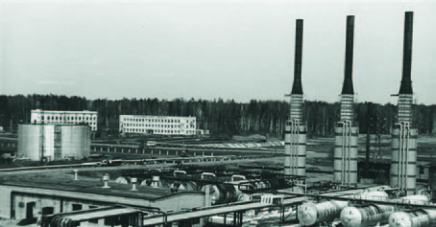Basic HTML Version




24
growth
growth
25
About the Company
History
T
he first recorded oil seeps in
Bashkortostan date from the be-
ginning of the eighteenth cen-
tury. In 19111914, A.I. Sroslov, an indus-
trialist, started oil exploration in the
vicinity of Ishimbayevo and Kusyapkulovo.
In 1929, a group of geologists headed by
Aleksey Blokhin was dispatched to the
Ishimbayevo District in Bashkiria on the
initiative of a famous Russian geologist
and scientist Ivan Gubkin. The research
conducted by the group proved that de-
tailed exploration in the area had been
justified.
The development of the Ishimbayskoye oilfield began
in 1932
, marking the start of commercial production
of crude oil in the Republic of Bashkortostan. Con-
struction of the Ishimbay oil refinery began in 1935.
The same year, Bashneft was set up as an independ-
ent trust comprising the Ishimbayskoye oilfield and
construction office, the Sterlitamak oil exploration
unit, a geology and field development office, and a
number of other departments.
After the Tuimazinskoye field was discovered
in 1937
,
the Tuimazinsky field development unit was created.
In 1938, the Ufa Oil Refinery (now OJSC Ufimsky refin-
ery plant) was commissioned.
By 1939
, Bashkortostan accounted for about 90% of all
oil production in the Urals and Volga region.
In 1944
, Devonian oil pools were discovered at the
Tuimazinskoye field signalling new prospects for oil
production in the Urals and Volga region. In 1946,
Bashneft Production Union was created, comprising
the Ishimbayneft, Tuimazaneft, Bashnefterazvedka
trusts, and Bashneftestroy, the Krasny Proletary
and Ishimbay Machine-building factories, as well as
Bashnefteprojekt and Bashtekhsnabneft.
In 1950–1953
, the Konstantinovskoye and Leonidovs-
koye Devonian oilfields and the Shkapovskoye multi-
zone oilfield were discovered at the eastern extension
of the Seraphimovskaya structure. The Chekmagush-
evskoye terrigenous Devonian oilfield was discovered
and exploration drilling started in the Birskaya saddle.
Bashneft is the leader among Russian oil
companies in terms of crude oil refining
depth, refinery equipment (the Nelson in-
dex) and production growth rate
In 1951
, the Novo-Ufimsky Refinery (now OJSC Novoil)
was commissioned in preparation for a rapid increase
in oil production in Bashkortostan.
In 1954
, the Mancharovskoye oilfield was discovered.
This was followed a year later by the discovery of the
Arlanskoye oilfield, the largest oilfield in the region.
Bashkortostan became the biggest oil-producing
region of the USSR, producing more than 15 million
tonnes.
In 1956
, construction of the Ufa Synthetic Spirit Plant
(now Ufaorgsintez) was completed. The Plant became
the first petrochemical facility in Bashkortostan
and one of the biggest facilities in the Soviet Union
manufacturing organic synthesis products. In 1957,
the third refinery in the Ufa group, Ufaneftekhim, was
commissioned. In 1962, the first Soviet diesel fuel
hydrotreater was constructed at the Ufimsky refinery
plant.
In 1967
, Bashneft reached peak production of about
48 million tonnes.
On January 13, 1995
, Joint-Stock Oil Company
(JSOC) Bashneft was established.
In 1998
, Bashneft started oil production in the
Khanty-Mansi Autonomous District.
In 2005
, JSFC Sistema bought the first blocking stake
in JSOC Bashneft, as well as in four oil refineries and
Bashkirnefteprodukt. In March 2009, JSFC Sistema
became the main shareholder of six Bashkortostan’s
fuel and energy enterprises.
In January 2010
, JSOC Bashneft bought a con-
trolling stake in OJSC Ufaneftekhim, OJSC Novoil,
OJSC Ufimsky refinery plant, OJSC Ufaorgsintez and
OJSC Bashkirnefteproduct from JSFC Sistema and be-
came the managing company for the new oil holding.
In 2010
, Bashneft completed its transformation into
a federal-scale vertically integrated oil company.
Bashneft entered the Timan-Pechora oil province, ob-
taining a licence for the development of a subsoil area
of federal significance including the Trebs and Titov
fields in the Nenets Autonomous District. In April
2011, an agreement was signed with OJSC Lukoil on
a joint project in Timan-Pechora.

